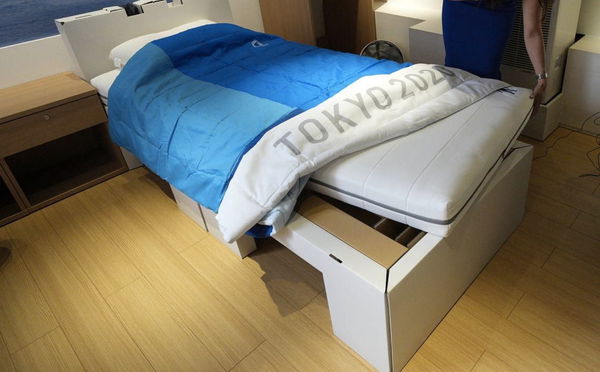

With the many restrictions and social distancing protocols at the 2021 Tokyo Olympics due to COVID-19, all eyes are now on the Paris Olympics to offer a more relaxed and memorable experience. The tradition of handing out condoms to athletes, which started at the 1988 Seoul Olympics to promote safe s*x, continued in Tokyo with the distribution of 160,000 condoms. However, the COVID-19 protocols at the time severely limited any close interactions in the Olympic Village.
Watch What’s Trending Now!
As the 2024 Paris Olympics approach, the City of Love is planning to distribute a whopping 300,000 condoms to promote safe s*x among athletes. But there’s a quirky twist: the infamous “anti-s*x” beds from Tokyo are making a comeback. This news has sparked global interest, especially since some athletes famously destroyed those beds at the Tokyo Games. It seems Paris is set for an interesting mix of romance and practicality!
ADVERTISEMENT
How athletes destroyed the beds at the Tokyo Olympics
A post on X by an account called @kann_news recently surfaced, showcasing a TikTok video uploaded by Ben Wagner, during the 2021 Tokyo Olympics. In the video, the players decided to test the durability of the beds in the Olympic Village by jumping on one until it broke. The footage began with Ben Wagner saying to the camera, “So today we’re going to check and see how many Israelis it takes to break one of these cardboard beds.”
"נראה כמה ישראלים צריך כדי לשבור את אחת ממיטות הקרטון": סרטון טיקטוק שהעלה שחקן נבחרת הבייסבול של ישראל לטוקיו 2020, בן ווגנר, מראה את שחקני הנבחרת "בוחנים" את עמידות המיטות בכפר האולימפי, כשהם קופצים על אחת המיטות בחדר עד שהיא נשברת@lianwildau pic.twitter.com/ATfDU70lww
— כאן חדשות (@kann_news) July 27, 2021
They gradually increased the number of athletes jumping on the bed from one to nine. When the ninth athlete joined in the bed-testing exercise, it finally collapsed. It turns out the magic number was nine. The Tokyo Olympics of 2021 marked a historic moment as all beds and bedding were crafted from nearly entirely sustainable materials, a first in Olympic and Paralympic history.
ADVERTISEMENT
Airweave, a Japanese mattress and bed brand, had given 18,000 cardboard beds with solid structures to the Olympic competitors and 8,000 beds specifically for the Paralympians. After the Olympics, the creative cardboard structures were reportedly repurposed into paper goods, while the mattresses were recycled into new plastic products. At the time, Takashi Kitajima, the general manager of the Olympic and Paralympic Village, assured that despite being made of cardboard, the beds would be “stronger than wooden beds” and emphasized their comfort.
Top Stories
NFL Suspends Chargers’ Denzel Perryman for Two Games Over Cowboys Incident

Clark Hunt Admits Being Pressured to Leave Arrowhead After Chiefs Offered $2.4B Proposal

Steelers Confirm $45M Punishment for DK Metcalf After NFL Suspended WR for 2-Games

Sean McDermott Confirms if Bills Will Sign a QB Amid Josh Allen’s Injury Concerns

Lee Trevino, 86, Leaves Golf World Hanging on Every Word at PNC: ‘I’ve Been Digging Worms’

Trent Williams Announces Retirement Plans After 49ers Clinch Playoff With Win vs Colts

ADVERTISEMENT

Kitajima also stated that the beds could hold up to 441 pounds. However, many speculated that the real reason for the switch to cardboard beds was to discourage intimacy among athletes in order to maintain social distance. While many applauded the initiative of sustainability and safety, others shed light on the fact that the beds were fragile. Team USA track and field athlete Paul Chelimo tweeted that the beds were “aimed at avoiding intimacy among athletes” but could withstand the weight of only one person.
ADVERTISEMENT
However, Irish gymnast Rhys McClenaghan took to Twitter to challenge Chelimo’s claim by jumping on one to prove his point. Meanwhile, Wagner and his baseball teammates decided to test the theory that the beds could hold up to 441 pounds by jumping on one until it broke. As this video resurfaces three years later, it’s interesting to see how these “anti-s*x” beds are making a comeback at the Paris Olympics.
The return of anti-s*x beds despite 300,000 condoms to be distributed at the Paris Olympics
According to the New York Post, the return of the cardboard beds designed by Airweave from the Tokyo Olympics to the Paris Olympics, this time aimed at promoting sustainability, has sparked a wave of speculation. While the twin-sized beds are designed to discourage athletes from getting too cozy, with just enough space for one person, they are also fully recyclable, a move in line with the Games’ efforts to reduce environmental impact.
ADVERTISEMENT

ADVERTISEMENT
However, the irony of the situation is not lost, especially considering the 300,000 condoms to be distributed in the Olympic Village. Despite the attempt to promote sustainability, the Village Club encourages mixing among nations, showing that while the beds may be anti-s*x, the Games are still very much embracing the spirit of connection and camaraderie. What are your thoughts on the return of the anti-s*x beds? Comment below!
ADVERTISEMENT
ADVERTISEMENT
ADVERTISEMENT

